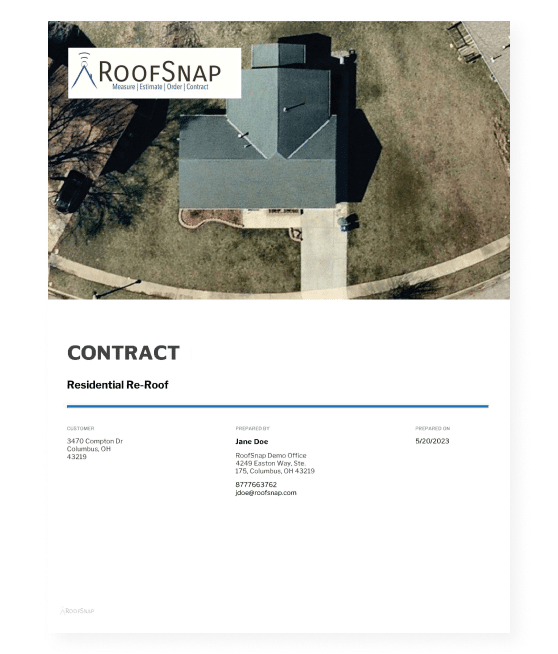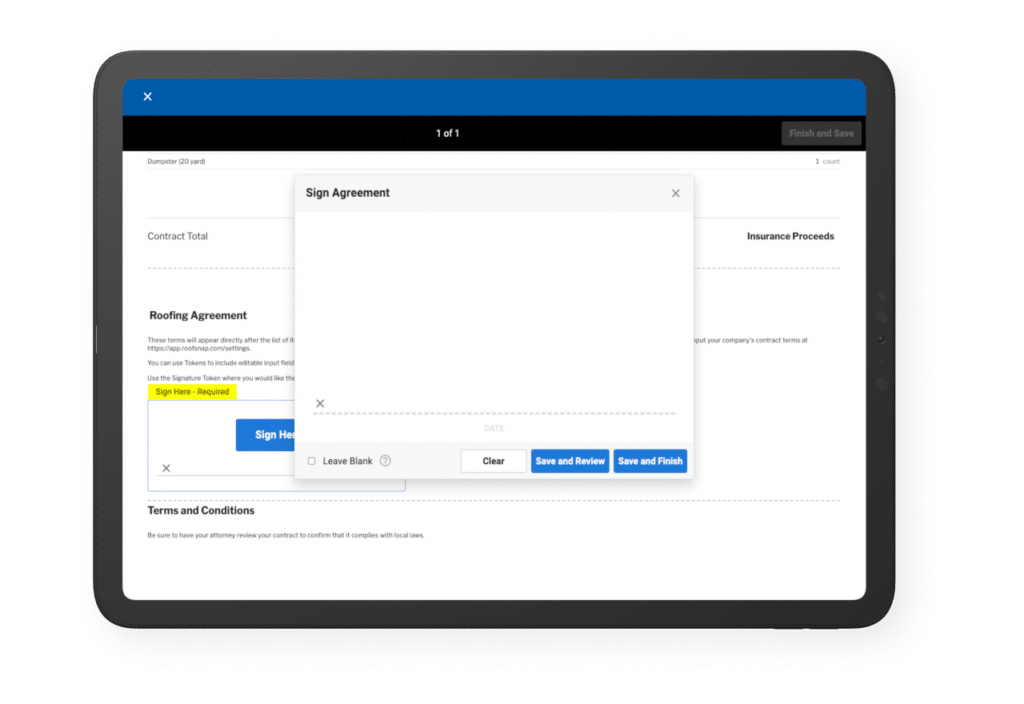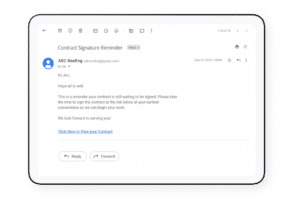All You Need to Manage
Roofing Contracts
RoofSnap streamlines roofing contracts. Convert estimates to customizable, e-signable
contracts fast. Get all you need to simplify your workflow and win more jobs.
Create Your Own Roofing Contract for Free
Sign up for a free trial and get all you need to create roofing contracts fast. Our template is fully customizable and covers all the essentials, including scope of work, timeline, and cost. Easily convert estimates into contracts, add your logo, and get ready to win jobs.
*Depending on where your business is located, you may need to add specific legal terms, language, and/or clauses not included in our software’s template. We recommend consulting a lawyer or legal service about what legal copy to include.

Everything You Need to Manage Documents
All you need to manage roofing documents—RoofSnap keeps contracts, reports, and estimates organized, easy to access, customizable, and shareable, so you save time and stay in control.
- Keep contracts, reports, and estimates in one place
- Customize every document with your logo
- Track deadlines and expirations effortlessly
- Share and update files instantly, anywhere


Electronic Contract Signing Made Easy
RoofSnap gives you all you need to sign contracts electronically—fast, secure, and flexible. Use any device to sign in person or remotely, keep workflows moving, and instantly share signed documents with your team and customers.
- Sign contracts from any device, anywhere
- Save time with instant electronic signatures
- Keep your workflow moving smoothly
- Share signed documents immediately
All You Need for Roofing Contracts
Running a roofing business involves many steps between first contact with a potential customer and stepping onto the roof for a project. One of the most important—and often overlooked—steps is creating and executing a roofing contract. A strong contract protects your business, your team, and your customers, while keeping projects on track.
A well-crafted roofing contract ensures:
- Clarity: Everyone is aligned on the work, timeline, and payment terms.
- Protection: Safeguards your business in case of disputes or legal issues.
- Professionalism: Demonstrates reliability and builds customer trust.
- Time savings: Streamlines the process, prevents misunderstandings, and helps projects finish on schedule.
- Legal compliance: Some contracts may require specific legal clauses to meet local laws.
You don’t have time to start from scratch every time. RoofSnap gives you all you need with customizable contract templates you can manage easily. Turn estimates into contracts quickly, add your branding, and streamline your sales process—without the complexity.
Need a less painful way to manage your roofing contracts?
Try RoofSnap’s Document Management & E-Signature features for free.
Roofing Contract FAQs
There’s no one way to write a roof contract. Generally, though, you’ll find many of the same key elements in all roofing contracts, including the scope of work, the timeline, the cost, and any other important details.
A roofing contract should be written clearly, so that the terms and scope are easy to understand. You can use a roofing contract template to simplify the process and help ensure that you cover all the necessary elements.
An even faster method is to use roofing software. Software can take your estimates and quickly convert them into contracts, with whatever custom contract terms you’d like to include.
A roofing contract should include several basic elements to ensure that both you (the roofing contractor) and your customer are on the same page regarding the scope of work and payment terms.
Here are some of the key elements that should be included in a roofing contract:
- Parties: Include your name and address (as the contractor) and the customer’s name and address.
- Description of the work: The roofing contract should include a detailed description of the work to be completed, including the scope of the project, the materials to be used, and any special requirements or specifications.
- Timeline: The contract should specify the start date and expected completion date of the project, as well as any milestones along the way.
- Payment terms: The contract should outline the payment schedule, including the total cost of the project. If relevant, also include the deposit required and the timeline for additional payments.
- Warranties: The contract should describe any warranties or guarantees you offer on the materials and workmanship.
- Insurance: The contract should confirm that you have the necessary insurance coverage, such as general liability and worker’s compensation insurance.
- Permits: The contract should specify which party will obtain any necessary permits or approvals for the roofing project.
- Change orders: The contract should include provisions for change orders, which will allow for modifications to the project scope, timeline, or cost if necessary.
- Dispute resolution: The contract should include a dispute resolution clause that outlines the process for resolving any disputes that may arise during the project.
- Other legal terms and requirements: There are likely particular legal terms and agreements you should include that are specific to your location. Before putting any contract template to use, you should consult a legal professional.
- Date and signatures: The contract must be dated and signed by both parties in order to be legally binding.
By including all of these elements in a roofing contract, you and your customers can have a clear understanding of the work to be done, the payment terms, and other important aspects of the project. All of this can help ensure a smooth and successful outcome.
By the time you’ve prepared an estimate for a customer, you’ve already gathered much of the information you’ll need to prepare a contract.
Take the relevant details from your roof estimate, like the scope of work, timeline, and cost, and put them into your contract template (that also has all the legal requirements). Then, you have a document that’s ready to sign.
You can simplify the process even further by taking advantage of roofing software, which often integrates estimates and contracts. So once a customer has agreed to the terms of the estimate you’ve prepared, you can quickly generate a contract with all the same information. It’s that easy!
Yes, in most cases, an electronically signed contract is just as legal as a physically signed one. There are two laws governing electronic signatures in the U.S.: the Uniform Electronic Transactions Act (UETA) and the Electronic Signature in Global and National Commerce (ESIGN) Act.
Depending on where you live, there may be state laws and regulations that govern the use of electronic signatures, so you’ll want to research and be aware of your state’s e-signature laws.
And, we always recommend you run your contract template by an attorney before putting one to use.

So you’ve sent the contract and then…you never hear anything back. Now what?
We all need reminders, sometimes—whether we’re talking about an appointment, a due date, or signing your roofing contract. Therefore, as a roofing professional, you should incorporate sending follow ups as part of your best practice for handling contracts effectively.
80% of sales can require an average of five follow-ups in order to finalize the deal. So sending follow up emails will help you keep customers informed and engaged, and get more contracts signed. Don’t let potential customers slip away—follow up instead and keep the sales process moving.
Ready for an easier way to manage your contracts?
Try RoofSnap’s Document Management & E-Signature tools to
simplify your workflow today.